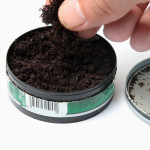- Smokeless tobacco is just as bad for your health as smoking cigarettes.
- Chewing tobacco stains your teeth, causes bad breath, mouth sores, and cancer.
- If you use smokeless tobacco, talk to your health care provider (HCP) about how to quit.
 Have you ever seen a professional baseball player, or even a teammate chewing and spitting in the dugout or on the field? Wonder what they were up to? Despite the lack of actual smoke, smokeless tobacco is just as bad for your health as cigarettes.
Have you ever seen a professional baseball player, or even a teammate chewing and spitting in the dugout or on the field? Wonder what they were up to? Despite the lack of actual smoke, smokeless tobacco is just as bad for your health as cigarettes.
What is smokeless tobacco?
The most common types of smokeless tobacco in the US are chewing tobacco, “plug”, “twist”, “snuff”, “snus”, and dissolvable tobacco products. All of these products are made from tobacco leaves, but they can be used in different ways, have different packaging, and may have added flavoring.
- Chewing tobacco pouches hold loose, sweetened tobacco leaves.
- Plug is loose tobacco leaves that have been sweetened and pressed into a brick shape.
- Twist is loose, flavored tobacco leaves that have been braided and twisted into strands.
- Snuff is either dry or moist finely ground (or shredded) tobacco leaves that come in tins or pouches.
- Snus is a smokeless and spitless tobacco product that comes in a pouch.
- Dissolvable tobacco products look like hard candies and are made of compressed powdered tobacco.
The various forms of smokeless tobacco are used in different ways. All forms are bad for your health!
Depending on the product, users may:
- Chew the tobacco and spit or swallow the liquid
- Sniff it (dry tobacco) through their nose
- Let it dissolve in their mouth
- Leave it in their mouth and then throw it out (snus)
Who uses it?
Research shows that about 15% of male teens and 3% of female teens have used some type of smokeless tobacco[GE1] [FS2] . Many professional baseball players use smokeless tobacco which may glamorize its use. However, these players are often addicted to it and are at risk for many health problems. According to the Center for Disease Control (CDC), 5.6 million of teens living in the United States will die early from smoking related illnesses, that’s 1 in every 13 teens living in the US today.
What can using smokeless tobacco do to me?
Most people don’t realize that using smokeless tobacco is just as dangerous as smoking it. Smokeless tobacco is definitely not a safe substitute. In the short term, you’ll have:
- Bad breath
- Stains on your teeth
- Mouth sores
Over a longer period of time using smokeless tobacco will cause:
- Your body to become dependent on it
- Your lips to crack, and both your lips and gums to bleed
- Your gums to recede (pull back from the teeth), possibly leading to your teeth falling out
- Your heart rate and blood pressure to rise and your heartbeat to become irregular. This can lead to a greater risk of a heart attack or stroke.
- Your risk of developing cancer of the mouth, lips, tongue, esophagus, stomach, and bladder will go way up. These cancers are very serious. Only about half the people diagnosed with mouth and throat cancer survive more than 5 years after being diagnosed.
More reasons why using smokeless tobacco is a bad habit:
- You can’t get rid of the stains on your teeth by brushing them, and tobacco juice stains can also ruin your clothes and other fabrics.
- Other people (including girls or guys you might want to date) will probably find the smell of your breath unpleasant.
- It’s expensive. A 2-can-a-week dip habit costs about $300 per year, and a pouch-a-day habit costs over $700 per year. Think about what you could do with the money you’d be saving – you could put it towards savings for college, a car, a vacation, etc.
What if I only chew once in a while? Can’t I just stop whenever I want?
Many people don’t realize they’re addicted, and they think that they can quit using smokeless tobacco anytime they want. Unfortunately, nicotine (the drug in smokeless tobacco and cigarettes) is addictive. There is actually 3-4 times more nicotine absorbed in the body using smokeless tobacco compared to cigarettes. So even if you only chew once in a while, you’re at risk of becoming addicted.
How do I quit using smokeless tobacco?
- Tell your health care provider, family, friends, and coaches so that they can provide support.
- Ask anyone who uses smokeless tobacco not to use it around you or offer it to you.
- Try cutting down over a period of time rather than trying to stop “cold turkey”, and then pick a final quit date.
- Check with your health care provider about whether using nicotine gum or a nicotine patch is an option for you.
- Try using substitutes such as tobacco-free mint leaf snuff, sugarless gum, hard candy, beef jerky, sunflower seeds, or dried fruit.
- Exercise – it will help you relax, curb cravings, and boost your energy.
- Eat regular, well-balanced meals. Hunger can be mistaken for a tobacco craving.
Using smokeless tobacco is not a safe alternative to cigarette smoking. It may be challenging to quit but YOU CAN DO IT! Expect to have cravings when you first quit. However, if you don’t succeed on the first or second try, try again. Remember, withdrawal symptoms will get better every day you don’t use tobacco, and the worst will be over after 2 weeks.
 Young Men's Health
Young Men's Health
